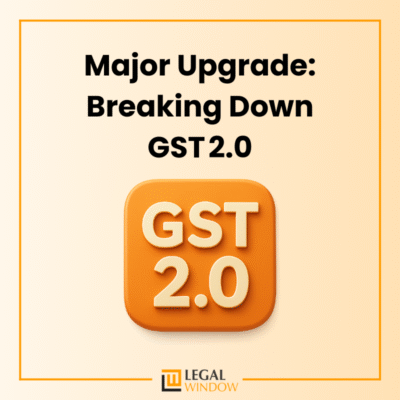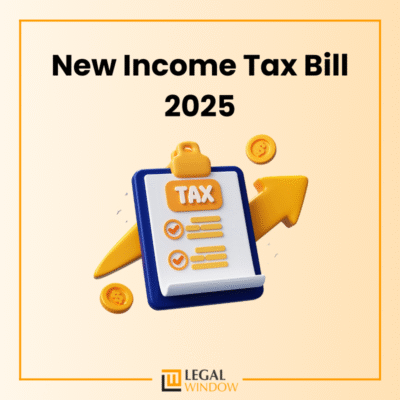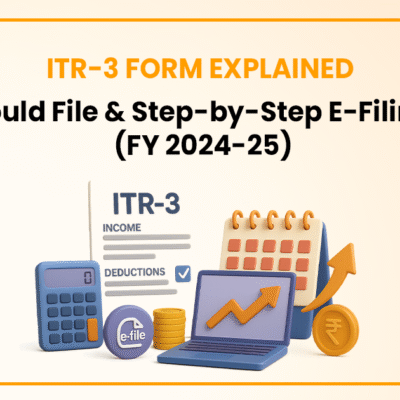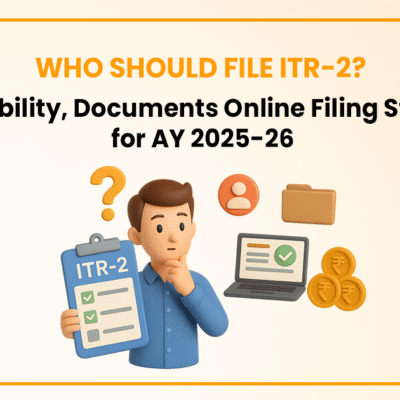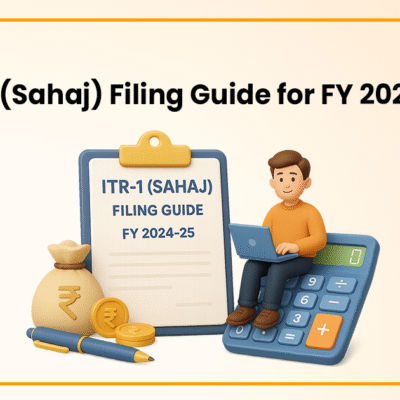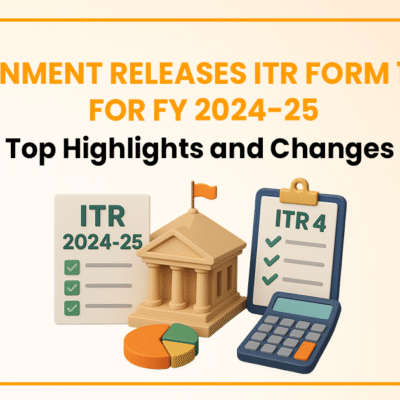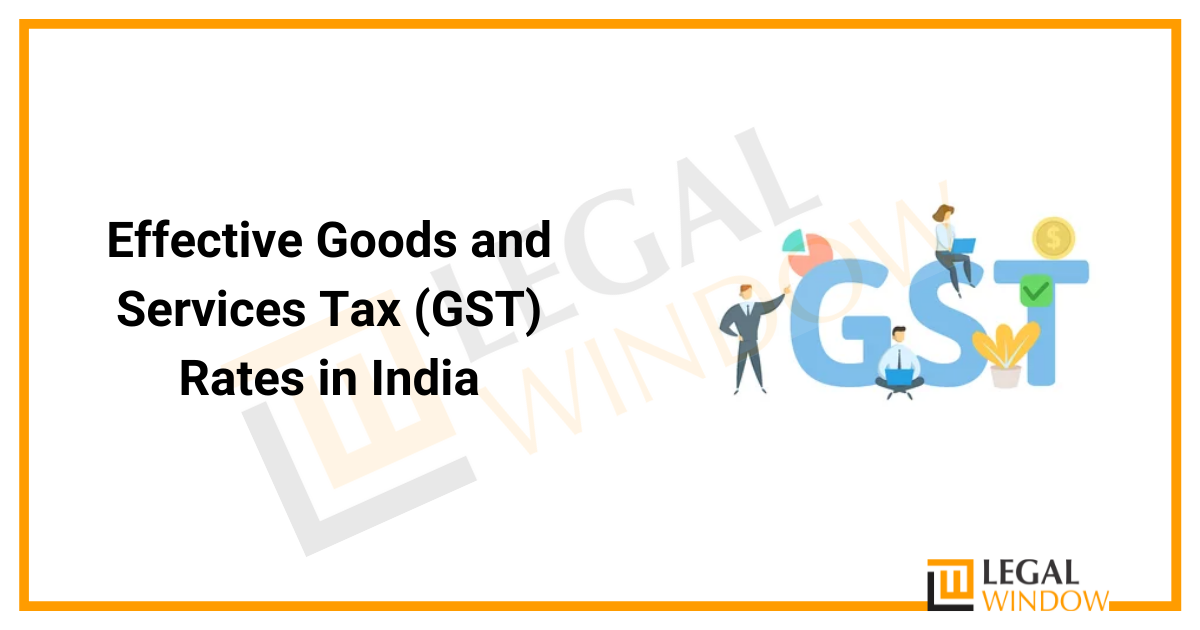
By introducing uniformity and openness to the Indian tax system, the GST (Goods and Services Tax) has transformed the outlook of the Indian tax system. It is amongst the most major tax reforms implemented to eliminate the previous tax system's cascading effect. Since the implementation of GST in India, the GST rate structure has undergone various adjustments. The Central Board of Indirect Taxes and Customs (CBIC) recently announced a 5 percent to 12 percent rise in the goods and service tax rates (GST rates) on several categories of textiles, clothing, and footwear, beginning January 1, 2022. Legal Window will guide throughout this blog about these effective rates. So, let’s talk about India's Effective GST Rate Slabs in India.
What do you mean by GST and GST Slab Rates?
GST, or Goods and Services Tax, is an indirect tax law that applies throughout India. Multiple indirect taxes have been replaced, including excise duty, service tax, value-added tax, octroi, entry tax, and luxury tax. In India, laws governing the subject went into force on July 1, 2017. The GST is a multi-staged tax that is imposed at each stage of the manufacturing process, but it is intended to be refunded to all parties involved in the various stages of production except the final consumer, and it is a destination-based tax that is collected from the point of consumption rather than the point of origin, as previous taxes were.
The four major GST slabs cover almost 500 services and over 1300 items in India. There are five different percentages: 5%, 12%, 18%, and 28%. The GST Council reviews the items included in each slab rate on a regular basis to ensure that they are still relevant to industry demands and market developments. The new framework ensures that basic commodities are taxed at lower rates, while luxury goods and services are taxed at higher rates.
The 46th GST Council Meeting
Smt. Nirmala Sitharaman, Union Finance Minister, presided over the GST Council's 46th meeting in New Delhi. The GST Council has advised deferring the decision to amend textile rate recommendations made at the 45th GST Council meeting. As a result, the present GST rates of 5 percent instead of 12 percent in the textile industry will be maintained. Gujarat, West Bengal, Tamil Nadu, Delhi, and Rajasthan have all spoken out against raising the GST (Goods and Services Tax) rate on textiles from 5% to 12%, with full effect on January 1, 2022. They said that raising the rate would just make things more difficult for MSMEs and raise the cost of "poor man's apparel.
The GST on Apparel, Textile Products, and Footwear
- Beginning in January 2022, the government will hike the goods and services tax on completed items such as clothing, textiles, and footwear from 5% to 12%. Beginning in January 2022, the GST rate on textiles will be hiked from 5% to 12.5%. In addition, the GST rate on all clothes has been hiked from 5% to 12%. Previously, products with a value of up to Rs. 1,000 were subject to a 5% GST.
- At its September meeting, the GST Council agreed to fix the inverted duty structure in textiles and footwear. It went on to indicate that the same will go into effect on January 1, 2022, with the effective rates to be set subsequently.
- The Finance Ministry has rationalised the tax rate on several raw materials used in the manufacturing of textile goods, in addition to hiking GST rates on footwear and textile items with a retail value of less than Rs 1,000. Instead of a variety of tax rates ranging from 5% to 18%, such basic commodities will be taxed at a flat rate of 12% beginning January 1 next year.
The most recent GST Tax slab rates for various goods categories
- Food and beverage goods are subject to GST as: The GST rates on the number of items in this category have been decreased. Those who previously had 18 percent GST now have 12 percent GST, while those who previously had 28 percent GST now have 18 percent GST.
- GST on everyday household goods: Several items in the category of household goods now have lower GST rates. Those who previously paid 18 percent GST now pay 12 percent or 5% GST. 18%, 5%, and even 0% GST rates are available to those with a GST rate of 28 percent.
- GST on items related to safety and security: There have been no significant changes from the previous 18 percent rate.
- GST on non-essential commodities: Several things formerly subject to a 28 percent GST are now subject to an 18 percent GST, those previously subject to an 18 percent GST are now subject to a 12 percent GST, and those previously subject to a 5 percent GST are now subject to a 0% GST.
- GST applies to educational materials: GST rates have been decreased from 28 percent to 12 percent for a number of commodities in this category.
- Medical and health-related items are subject to GST: GST is cut from 12 percent to 5% for goods in the medical and health category, and 0% for standalone items.
- GST on agricultural products: Agriculture items that previously had a 12 percent GST now have a 5% GST. Items previously subject to an 18 percent GST rate now have a lower GST charge of 12 percent.
- Infrastructure, fuel, and environmental commodities are all subject to the GST: Items in this category that formerly had a 28 percent GST now have an 18 percent GST. Items that previously had an 18 percent GST rate now have a 12 percent rate.
Goods and Services under 0% Rates
- Independent bodies, government organizations, educational institutions, religious institutions, and medical and health-care institutions all provide services.
- Folk cultural performances, performance arts, circus, dance, and theatre acts that cost less than Rs. 250 per person.
- There will be no taxes on items such as sanitary napkins, Rakhis made without valuable metals such as gold or silver, raw materials used in brooms, Saal leaves and calcium - fortified, fruits, vegetable, bread, salt, wheat, eggs, stamps, printed books, administrative papers, magazines, and so on.
- Under section 12 AA of the Information Technology Act, 2000 services offered for philanthropic purposes, arts or culture, and charitable sports are defined.
- Services provided to an Indian embassy, a foreign diplomat, and UN organisations
List of Services which includes less than 12% of GST Rate
- Food and beverage service in restaurants with air conditioning and central heating but no liquor licence.
- Accommodation services costing more than Rs. 1000 per day but less than Rs. 2500 per day are available.
Tax on Gold in India
Since the introduction of gold-made articles (jewellery) into the GST system, the appropriate rates have been set at 3%. If the manufacturing task is outsourced from a job worker, however, a 5% GST is applied as jewellery creating charges. The jeweller is obligated to claim these making expenditures as an input tax credit (ITC), which reduces the final price to a chargeable 3 percent GST charge for the buyer. Learn more about the GST on Gold and how it will affect the gold industry.
Conclusion
In comparison, we may conclude that, because India has several GST tax rates compared to a single GST rate in other affluent nations throughout the world, the national economy will undergo a significant transition from the days of many taxes. We can see that while some items and services will become less expensive, others will cost consumers more money. With knowing the facts about GST Rates one needs to file GST returns which our Experts will guide you effectively. So feel free to contact us on Legal Window, if you have any queries.
Company Secretary and diligent learner deeply immersed in the world of corporate law, compliance, and governance with a focus on developing a robust foundation in legal principles and corporate practices. Passionate about exploring the intricacies of company law, regulatory compliance, and corporate governance.
Categories
- Agreement Drafting (23)
- Annual Compliance (13)
- Change in Business (37)
- Company Law (150)
- Compliance (90)
- Digital Banking (3)
- Drug License (4)
- FEMA (17)
- Finance Company (42)
- Foreign Taxation (9)
- FSSAI License/Registration (15)
- GST (124)
- Hallmark Registration (1)
- Income Tax (214)
- Latest News (36)
- Miscellaneous (170)
- NBFC Registration (8)
- NGO (18)
- SEBI Registration (6)
- Section 8 Company (10)
- Start and manage a business (27)
- Startup/ Registration (134)
- Trademark Registration/IPR (48)
Recent Posts
- Major Upgrade: Breaking Down GST 2.0 September 15, 2025
- New Income Tax Bill 2025 August 27, 2025
- ITR-3 Form Explained: Who Should File & Step-by-Step E-Filing Guide (FY 2024-25) June 25, 2025
All Website Tags
About us
LegalWindow.in is a professional technology driven platform of multidisciplined experts like CA/CS/Lawyers spanning with an aim to provide concrete solution to individuals, start-ups and other business organisation by maximising their growth at an affordable cost.


